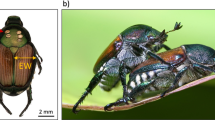Abstract
The nematode Sphaerularia vespae only parasitizes hornet queens and deprives them of fertility. To elucidate its transmission route, we observed the behavior of overwintered queens of Vespa simillima found around decayed logs of fallen trees—the principal hibernation sites for this species. We found that overwintered queens frequently visited those decayed logs in summer (late June to mid-August), hovering or walking on the surfaces of the logs, and sometimes entering holes or cracks there. These queens, unlike those visiting the hibernation sites in the fall, did not excavate wood to make their hibernacula, but often released juvenile nematodes there. In 25 % of the entries observed, we confirmed that juvenile nematodes had been released from the tips of the hornet’s gasters and thus transferred to the decayed logs. The timing of the host’s initial visit to decayed logs for nematode transmission corresponded well with the hatching of juveniles within the host’s body. These results suggest that the parasitic nematode manipulates its host to visit decayed logs in summer for its own transmission.



Similar content being viewed by others
References
Alford D.V. 1975. Bumblebees. Davis-Poynter, London
Archer M.E. 1994. Taxonomy, distribution and nesting biology of the Vespa bicolor group (Hym., Vespidae). Entomol. Mon. Mag. 130: 149-158
Archer M.E. 2012. Vespine Wasps of the World: Behaviour, Ecology & Taxonomy of the Vespinae. Siri Scientific Press, Manchester
Bedding R.A. 1984. Nematode parasites of Hymenoptera. In: Plant and Insect Nematodes (Nickle W.R., Ed), Marcel Dekker, New York. pp 755-795
Brodeur J. and Vet L.E.M. 1994. Usurpation of host behaviour by a parasitic wasp. Anim. Behav. 48: 187-192
Carpenter J.M. and Kojima J. 1997. Checklist of the species in the subfamily Vespinae (Insecta: Hymenoptera: Vespidae). Nat. Hist. Bull. Ibaraki Univ. 1: 51-92
Cumber R.A. 1949. Humble-bee parasites and commensals found within a thirty mile radius of London. Proc. R. Entomol. Soc. London Ser. A 24: 119-127
Eberhard W.G. 2000. Spider manipulation by a wasp larva. Nature 406: 255-256
Evans H.C. 1989. Mycopathogens of insects of epigeal and aerial habitats. In: Insect-Fungus Interactions (Wilding N., Collins N.M., Hammond P.M. and Webber J.F., Eds). Academic Press, London. pp 205-238
Kanzaki N., Kosaka H., Sayama K., Takahashi J. and Makino S. 2007. Sphaerularia vespae sp. nov. (Nematoda, Tylenchomorpha, Sphaerularioidea), an endoparasite of a common Japanese hornet, Vespa simillima Smith (Insecta, Hymenoptera, Vespidae). Zool. Sci. 24: 1134-1142
Levri E.P. 1999. Parasite-induced change in host behavior of a freshwater snail: parasitic manipulation or byproduct of infection? Behav. Ecol. 10: 234-241
Lundberg H. and Svensson B.G. 1975. Studies on the behaviour of Bombus Latr. species (Hym., Apidae) parasitized by Sphaerularia bombi Dufour (Nematoda) in an alpine area. Nor. J. Entomol. 22: 129-134
Macfarlane R.P., Lipa J.J. and Liu H.J. 1995. Bumble bee pathogens and internal enemies. Bee World 76: 130-148
Makino S. and Sayama K. 2005. Species compositions of vespine wasps collected with bait traps in recreation forests in northern and central Japan (Insecta, Hymenoptera, Vespidae). Bull. Forestry Forest Prod. Res. Inst. 4: 283-289
Makino S., Yamane Sk., Ban T. and Kunou I. 1981. The Japanese hornet Vespa simillima Smith, an important nuisance pest in urban areas (Hymenoptera: Vespidae). Jap. J. Sanit. Zool. 32: 203-213
Matsuura M. 1991. Vespa and Provespa. In: The Social Biology of Wasps (Ross K.G. and Matthews R.W., Eds). Cornell University Press, Ithaca. pp 232-262
Matsuura M. and Yamane Sk. 1990. Biology of the Vespine Wasps. Springer-Verlag, Berlin
McCorquodale D.B., Beresford R.G., Francis J.M., Thomson C.E. and Bartlett C.M. 1998. Prevalence of Sphaerularia bombi (Nematoda: Tylenchida: Sphaerulariidae) in bumble bee queens (Hymenoptera: Apidae) on Cape Breton Island, Nova Scotia, Canada. Can. Entomol. 130: 877-882
McCurdy D.G., Forbes M.R. and Boates J.S. 1999. Evidence that the parasitic nematode Skrjabinoclava manipulates host Corophium behavior to increase transmission to the sandpiper, Calidris pusilla. Behav. Ecol. 10: 351-357
Moore J. 2002. Parasites and the Behavior of Animals. Oxford University Press, Oxford and New York
Müller C.B. 1994. Parasitoid induced digging behaviour in bumblebee workers. Anim. Behav. 48: 961-966
Poinar G.O. and van der Laan P.A. 1972. Morphology and life history of Sphaerularia bombi. Nematologica 18: 239-252
Sayama K., Kosaka H. and Makino S. 2007. The first record of infection and sterilization by the nematode Sphaerularia in hornets (Hymenoptera, Vespidae, Vespa). Insect. Soc. 54: 53-55
Schmid-Hempel P. 1998. Parasites in Social Insects. Princeton University Press, Princeton
Stein G. 1956. Weitere beiträge zur Biologie von Sphaerularia bombi Leon Dufour 1837. Z. Parasitenkunde 17: 383-393
Thomas F., Schmidt-Rhaesa A., Martin G., Manu C., Durand P. and Renaud F. 2002. Do hairworms (Nematomorpha) manipulate the water seeking behaviour of their terrestrial hosts? J. Evol. Biol. 15: 356-361
Yamane Sk. and Kanda E. 1979. Notes on the hibernation of some vespine wasps in northern Japan (Hymenoptera: Vespidae). Kontyû 47: 44-47
Acknowledgments
We thank Dr. K. Takahashi for valuable information on the study site at Mt. Moiwa, and the Agency for Cultural Affairs, Hokkaido Government Board of Education, and the City of Sapporo for granting us permission to conduct research at Mt. Moiwa. We also thank anonymous reviewers for improving the manuscript, and Dr. L. Beani who kindly recommended us to cite an informative e-mail from Prof. W.D. Hamilton to her. This study was supported by the Grant-in-Aid for Scientific Research (no. 20380097) from the Japan Society for the Promotion of Science.
Author information
Authors and Affiliations
Corresponding author
Electronic supplementary material
Below is the link to the electronic supplementary material.
ESM_1 (release of nematodes): A sequence of behaviors of the parasitized queen of Vespa simillima releasing juvenile nematodes near the opening of a hole in the decayed log. These behaviors were videotaped in Sapporo on 21 July 2008. (MPG 16894 kb)
Rights and permissions
About this article
Cite this article
Sayama, K., Kosaka, H. & Makino, S. Release of juvenile nematodes at hibernation sites by overwintered queens of the hornet Vespa simillima . Insect. Soc. 60, 383–388 (2013). https://doi.org/10.1007/s00040-013-0303-9
Received:
Revised:
Accepted:
Published:
Issue Date:
DOI: https://doi.org/10.1007/s00040-013-0303-9




